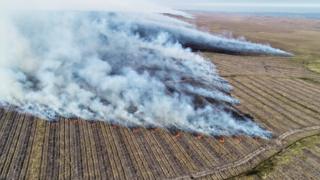[ad_1]

Image copyright
PAul Turner
The wildlife in the Flow Country burnt for six days in May
A massive wildfire on peatland in the far north in May doubled Scotland’s greenhouse gas emissions for the six days it burnt, a study has estimated.
About 22 sq miles (5,700 hectares) of blanket bog in the Flow Country, which stretches across Caithness and Sutherland, was affected.
The WWF Scotland study claimed 700,000 tonnes of CO2 equivalent was released into the atmosphere as a result.
That is similar to the amount released across the rest of Scotland.
Greenhouse gases, such as carbon dioxide, contribute to climate warming and are released by many activities such as energy supply, industrial processes, transport, heating and agriculture.
Image copyright
PAul Turner
The fire caused damage of thousands of acres
Image copyright
PAul Turner
The peatbog is a natural carbon store
Image copyright
Sentinel Hub
A satellite image of the Caithness fire on 16 May
Peat bogs are an important natural store for carbon.
The Flow Country, home to the largest continuous peatbog in Europe, is estimated to hold almost 1.5 billion tonnes of carbon dioxide equivalent (CO2e).
The study, commissioned by environmental campaign group WWF, called for more government investment to protect and improve peat bogs.
Head of policy Gina Hanrahan said: “This analysis puts into stark figures the importance of our peatlands and the huge cost to climate and nature when something goes wrong.”
Image copyright
Ahmad Aqel
The Flow Country peatbog is formed from layers of dead vegetation such a sphagnum moss
The Flow Country peatbog is formed from layers of dead vegetation such a sphagnum moss. Because of the waterlogged conditions, the plants do not decompose which traps carbon in the peat soil.
Experts say the quality of peatlands can play a significant role in minimising emissions in the event of a wildfire.
Emma Goodyer, from the International Union for Conservation of Nature (IUCN), said: “Healthy peatlands are more resilient to fire. A great deal of peatland restoration work is being undertaken across the UK already with at least 150 projects carried out in Scotland.
“However, we need to increase the scale of funding available for peatland restoration if we are to urgently respond to the climate crisis and to increase the resilience of our peatlands.”
Image copyright
PAul Turner
RSPB staff helping to tackle flare-ups of the wildfire
A Scottish government spokesman said restoring peatland had an important part to play in delivering climate change ambitions.
He said the government was committed to delivering the peatland restoration targets set out in the Climate Change Plan.
“We are currently updating our Climate Change Plan which will set out detailed actions to deliver on our climate change ambitions,” the spokesman said.
The fire stretched from the outskirts of Melvich on the north coast to the village of Forsinard, about 15 miles further south.
A long-term project is being carried out in the Flow Country to estimate the ecological impact of the fire.
Measurements gathered before the fire give researchers a unique data set for understanding the way vegetation and water quality has changed.
[ad_2]
Source link

